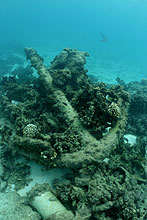NOWRAMP
2002
Wrecks
as Common Heritage: Looting and the Law
Written By Hans Van Tilburg, Ph.D, "Dr. Shipwreck"
Underwater Photography by Jim
Watt
 Many
divers have a fine appreciation for history and enjoy seeing
wreck sites underwater. Unfortunately, a few of them enjoy
this so much that they feel compelled to take some of it
home with them. There are a couple problems with this. First
of all, historic wrecks represent our common maritime past.
They are a scarce resource to be enjoyed, not to be randomly
stripped of artifacts and destroyed. Information about the
past, about the crew, the ship's construction, its trade,
the wrecking event itself, is preserved in subtle ways.
Any excavation or tampering with the site can destroy this
record. Second, according to state and federal preservation
laws, it is illegal to loot wrecks.
Many
divers have a fine appreciation for history and enjoy seeing
wreck sites underwater. Unfortunately, a few of them enjoy
this so much that they feel compelled to take some of it
home with them. There are a couple problems with this. First
of all, historic wrecks represent our common maritime past.
They are a scarce resource to be enjoyed, not to be randomly
stripped of artifacts and destroyed. Information about the
past, about the crew, the ship's construction, its trade,
the wrecking event itself, is preserved in subtle ways.
Any excavation or tampering with the site can destroy this
record. Second, according to state and federal preservation
laws, it is illegal to loot wrecks.
The
federal Abandoned Shipwreck Act of 1987 is one of the main
tools for the protection of our maritime past. This act
grants the state title to abandoned vessels in state waters,
and establishes management guidelines for the study, preservation,
and enjoyment of these unique historic resources. There
are literally hundreds of sites in Hawai‘i where vessels
have ended their careers, only natural for a maritime location
such as this. We are surrounded by the remains of ships
of exploration, local schooners, 19th century steamships
from the inter island trades, and more. These sites and
the information they contain are the real cultural "treasures"
beneath the waves.
 Navy
ships and aircraft are even more carefully managed. These
almost always remain property of the US government no matter
how deep they lie, and theft of material from them has led
to fines and jail time.
Navy
ships and aircraft are even more carefully managed. These
almost always remain property of the US government no matter
how deep they lie, and theft of material from them has led
to fines and jail time.
The
historic wrecks in the Northwestern Hawaiian Island chain
have been further protected by their isolation. (Unfortunately,
it's rare to find an unlooted wreck site in the main islands.)
That's something that makes these atolls even more special.
Stewardship of natural marine resources and cultural maritime
resources can go hand in hand. Both are forms of respect
for what the ocean possesses.